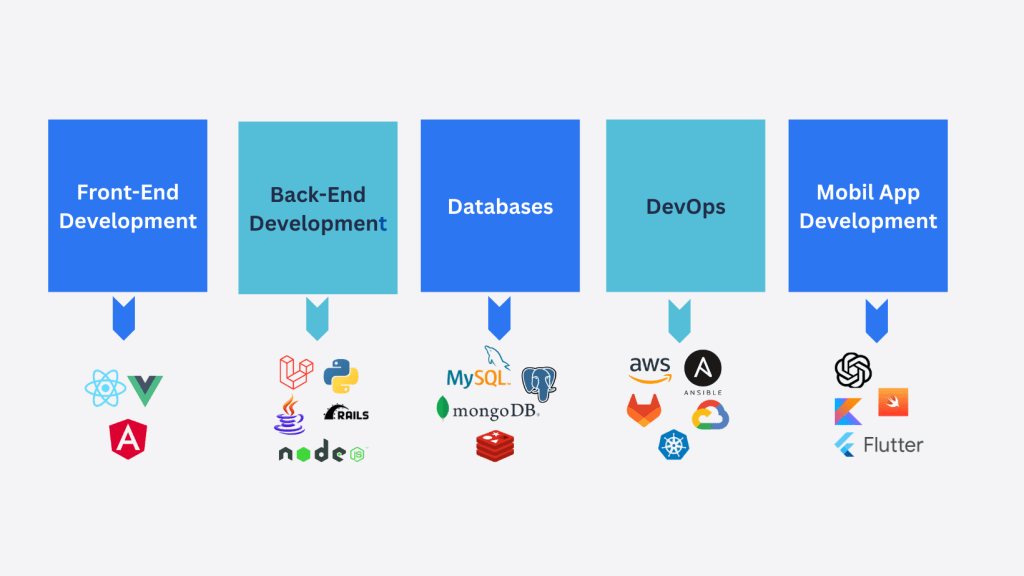Introduction to Full-Stack Development
Nowadays, businesses need apps that can adapt, grow, and work efficiently. That’s where full-stack development comes in. Full-stack developers are the experts who can handle both the front end (what users see and interact with) and the back end (the behind-the-scenes stuff that makes everything work). They’re like the all-in-one tool for app development—able to do everything from building the user interface to managing the server-side operations.
So why does this matter for businesses? It’s pretty straightforward—it speeds things up. When one person or a small team can manage both sides, you avoid a lot of the usual delays, and everything moves along faster. For startups and small companies, that’s a game-changer. You can launch sooner, save time, and cut costs.
Curious how Curotec’s technology services can help bring your full-stack projects to life? Let’s chat.
Front-end Development: Building the User Interface
Let’s start with the front end—the part users see and interact with. Front-end development is all about creating the visual aspects of a website or application. It involves working with technologies like HTML, CSS, and JavaScript to create an engaging, intuitive user interface (UI). A good UI significantly affects the user experience (UX). Think about it—if a website is clunky, slow, or hard to navigate, users will bounce and probably never return.
When it comes to modern front-end development, frameworks like React.js, Angular, and Vue.js are the heavy hitters. React.js, for example, is a popular choice because it allows developers to create reusable components, making development faster and more efficient. Whether crafting a responsive web design or ensuring cross-platform compatibility, front-end developers play a critical role in delivering a seamless experience to users.
Check out Curotec’s React and Vue.js development expertise to enhance your front-end projects.
Back-end Development: Powering the Application
While the front end is what users see and interact with, the back end is where all the magic happens. This is the part of the application that processes data, manages databases, and handles server-side logic to ensure everything runs smoothly. Without a strong back-end, even the most attractive front-end would struggle to deliver a seamless experience.
Developers use several powerful technologies for back-end development, including PHP, Node.js, Java, Python, and Ruby on Rails. Each of these technologies brings its own strengths, depending on the type of project.
PHP is a long-standing, reliable choice for web development, and one of the most popular PHP-based platforms is WordPress. WordPress powers a significant portion of websites globally, providing an easy-to-use content management system (CMS) that allows businesses to manage their site content without deep technical knowledge. It’s perfect for small to medium-sized websites that need frequent updates, such as blogs, corporate sites, or e-commerce stores.
For more complex projects, Laravel—a modern PHP framework—offers far greater flexibility, control, and scalability. Laravel is known for its elegant syntax and developer-friendly features, making it ideal for building custom web applications from the ground up. Unlike WordPress, which is primarily focused on CMS functionality, Laravel is a full-stack framework that’s perfect for developing anything from simple web apps to complex, enterprise-level systems.
One of Laravel’s greatest strengths is its modular structure, which allows developers to break down large applications into manageable components. It comes packed with features like built-in routing, authentication, and powerful database tools like Eloquent ORM, which simplify common tasks and speed up development. Additionally, Laravel integrates seamlessly with modern front-end technologies like Vue.js and React.js, enabling developers to create highly interactive, dynamic applications with ease.
Another popular option is Node.js, which allows developers to use JavaScript for both front-end and back-end development. This makes it an excellent choice for real-time applications, microservices, and projects that require a fast, non-blocking I/O model. Express.js, a framework for Node.js, is often used to build scalable, high-performance back-end services.
For enterprise-level applications, Java is often the language of choice. Known for its stability and reliability, Java is commonly used in large-scale systems that require high levels of performance and security. Frameworks like Spring provide developers with tools to build complex applications, from microservices architectures to enterprise-grade platforms.
Python is another key player in back-end development. Known for its ease of use and readability, Python is a versatile language that excels in various fields, from web development to data science and machine learning. Django and Flask, two popular Python frameworks, allow developers to build fast, secure, and scalable web applications. Python’s simplicity, combined with its powerful libraries, makes it especially useful for data-heavy applications or projects involving artificial intelligence.
These technologies—Laravel, Node.js, Java, and Python—offer a wide range of tools to ensure your application is not only functional but also secure, scalable, and high-performing.
Explore Curotec’s back-end services, including custom development using PHP, Laravel, WordPress, Node.js, Java, and Python, to see how we can help bring your application to life.
👋 Curious how full-stack development can propel your business? Let’s get a conversation started.
Database Management: Organizing and Accessing Data
An application is only as good as its data, and that’s why databases are such a critical component of full-stack development. Databases store and manage all the data that applications need to function—from user information to transaction details and everything in between. Full-stack developers must be proficient in both relational databases (like MySQL or PostgreSQL) and non-relational databases (like MongoDB).
The choice between SQL and NoSQL often depends on the project’s requirements. SQL databases are great for structured data where relationships between tables are important, while NoSQL databases excel at handling large volumes of unstructured data.
Explore Curotec’s capabilities in database management and how we help businesses handle their data effectively.
DevOps and Full-Stack Development
In today’s development world, full-stack developers don’t just build applications—they often play a role in deploying and maintaining them, too. That’s where DevOps comes into play. DevOps is a set of practices that combines development (Dev) and operations (Ops) to automate and streamline the process of building, testing, and deploying applications.
Understanding key DevOps concepts like Continuous Integration/Continuous Deployment (CI/CD) pipelines, cloud hosting, and automated testing can make a big difference for full-stack developers. These practices help teams push out updates faster, catch bugs earlier, and keep applications running smoothly in production.
Discover how Curotec can help you modernize your applications with DevOps and cloud solutions.
The Tools and Frameworks Full-Stack Developers Use
Full-stack developers have an impressive toolkit at their disposal, with tools and frameworks that make their jobs easier and more efficient. We have frameworks like Angular, React.js, and Vue.js on the front end. On the back end, the go-to options are languages like Node.js, Ruby on Rails, and Java. But it doesn’t stop there.
Version control systems like Git help developers keep track of changes to the codebase, while containerization tools like Docker enable them to create isolated environments for running applications. Full-stack developers also use testing frameworks to ensure their code works as expected—Jest, Mocha, JUnit, and Selenium are just a few popular ones.
A broad knowledge of these tools allows full-stack developers to adapt to different project needs and handle complex applications end-to-end.
| Aspect | Front-End Development | Back-End Development |
| Purpose | User interface and user experience | Server-side logic, data storage, processing |
| Technologies/Frameworks | HTML, CSS, JavaScript, React.js, Angular | PHP, Laravel, WordPress, Node.js, Java, Python, Django, Ruby on Rails |
| Main Responsibilities | Designing layouts, visual components, ensuring responsiveness | Managing databases, APIs, server configuration |
| Key Focus | Performance, design, accessibility | Security, scalability, performance optimization |
| Data Handling | Receives and displays data | Processes and manages data |
Why Choose Full-Stack Development for Your Project?
Full-stack development offers several benefits, making it an attractive choice for many businesses. For startups, it’s often the most cost-effective option, as hiring one full-stack developer can be more efficient than hiring separate frontend and back-end developers. The ability to iterate quickly and release features faster is another big plus.
For larger enterprises, full-stack development can lead to more cohesive collaboration between teams. Since full-stack developers understand both sides of the application, they can help bridge the gap between different departments, resulting in better communication and more efficient workflows.
Interested in how full-stack development can benefit your business? Check out Curotec’s full-stack services.
Curotec’s Full-Stack Development Expertise
At Curotec, we specialize in full-stack development, offering a comprehensive range of services to meet your project’s unique needs. Whether front-end development using the latest JavaScript frameworks or back-end development using scalable technologies like Node.js, Java, or Ruby on Rails, our team is equipped to deliver high-quality solutions. We don’t just build applications—we build applications that last, grow, and adapt to your evolving business needs.
Learn more about our full-stack development services and how we can help you build the right solution for your business.
Wrapping Up
Full-stack development has become a go-to solution for businesses looking to build modern, scalable applications quickly and efficiently. From creating engaging user interfaces to developing powerful back-end logic, full-stack developers are the backbone of any successful application. Whether you’re a startup looking to launch your MVP or an enterprise ready to scale your operations, full-stack development can provide the flexibility, speed, and innovation you need to succeed.
At Curotec, we’re here to help you take advantage of everything full-stack development has to offer. Reach out today to learn how we can partner with you to build the future of your business.



